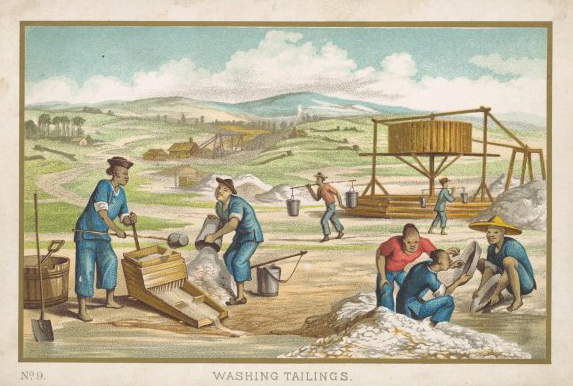Description
This chromolithograph shows seven Chinese miners panning and sluicing for gold during the gold rush in Australia in the 1870s. The miners all wear blue trousers, and five have matching blue shirts. There is a whim at the right of the image. The white frame of the image bears the captions 'WASHING TAILINGS' and 'No. 9'. This chromolithograph is part of the Rex Nan Kivell collection held at the National Library of Australia, and it is the ninth in a series of ten illustrations depicting Australian life during the 1870s. It measures 11.8 cm x 17.4 cm.
Educational value
- Thousands of Chinese people came to Australia in the 19th century to make their fortunes on the goldfields. The first arrived in 1853, and by 1858 the Chinese population had reached its gold-rush peak of around 40,000, or a little more than 3 per cent of the Australian population. Most worked on the goldfields for a few years, sending gold back to China, before returning to China and their families. In 1857, 5.8 tonnes of gold were shipped from Victoria to Guangdong province.
- The print shows a rocker cradle, puddling tub, whim and pans - the main tools of the alluvial goldminer in the 1850s. Miners carefully washed silt through the rocker cradle, also known as a Californian cradle, to separate gold and stones from larger rocks and silt. They then used the puddling tub and pan for the more delicate process of separating the gold from the remaining gravel. Whims were used for deeper deposits to haul buckets of excavated ore up a mine shaft.
- Illustrated in this print is the kind of teamwork that contributed to successful and efficient goldmining. Many of the Chinese gold seekers in the 1850s lived together in camps, which provided social support from people who spoke the same language, and would also have facilitated teamwork - initially in mining alluvial gold, and later in more complex mining techniques after the surface gold was depleted.
- Many Chinese gold seekers came from counties in Guangdong province. On arrival in Australia, many joined Chinese associations, often comprising people from their own local districts in China. The societies were set up to provide social support, protection, advice about the new country and culture, and assistance for members who were ill.
- The print gives a sense of the environmental degradation caused by gold digging and shows the barren landscape at the site of the dig. At the time, the processes that miners used to extract gold ranged from panning the surface layers to digging open mine shafts; both caused considerable damage to the environment. Tailings, the waste materials from the mining process, were often left when sites were deserted.
